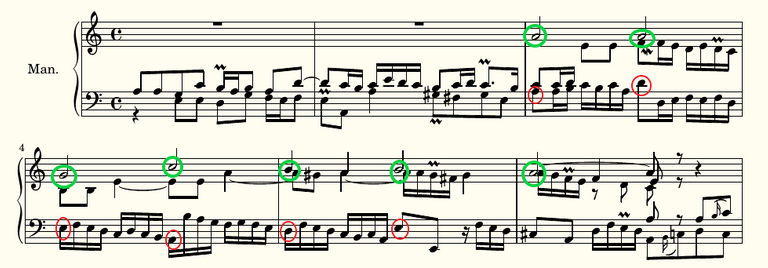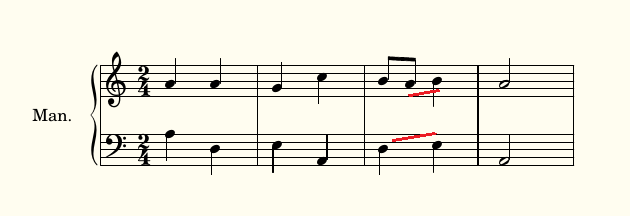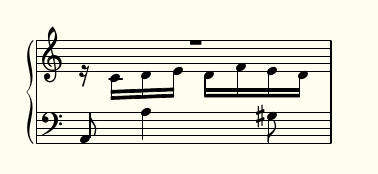How to compose a choral prelude (1)
Two weeks ago I published the score of a choral prelude by Johann Gottfried Walther, based on the melody of "Nun komm der Heiden Heiland" (in English: "Now come, Savior of the heathens"). In the accompanying post (https://steempeak.com/classical-music/@partitura/johann-gottfried-walther-nun-komm-der-heiden-heiland-vers-1) I wrote that even though Walther's composition seems simple, it is not easy to write music that flows so naturally. The few times I've tried to write something similar I failed miserably. Inspired by this particular choral prelude I decided to try once again. And while doing that I'm going to make some of my thought processes explicit by writing about it, in the hope that it helps me, and who knows, other people who are interested in this kind of stuff as well.
Now the goal is not to be original. Originality is the art one can acquire once one has mastered the craft. The goal is to look more detailed at what Walther does and emulate that. I am not going to copy Walther's notes, I am going to copy Walther's procedure in this particular choral prelude.
Let's have a look at the first 6 bars of Walther's composition:

Walther's composition is in three part writing, meaning that three different 'voices' or 'musical lines' can be discerned. Walther writes first two bars to establish the tonal key and uses material of the choral melody to do that. Only two of the three voices are playing in these two bars . Let's call the lowest of these two the bass voice, and the upper of these two (the middle voice of all three) the tenor voice. The upper voice (let's call that one the soprano voice) is silent. In bar three the choral melody enters in the soprano voice. In bars 3-6 the soprano voice plays the first phrase of the choral melody. To make it easy to see the choral melody in the music, I've emphasized them with green circles:

Anyone who has studied music a bit more than only playing it, knows that not only melody is important in music, the bass is equally important as well. Without bass there is no harmony and without harmony there is no music. Well, that last statement is a bit too strong. There is beautiful single voiced music, without bass. However, as soon as you write more then one voice, the lowest one of these becomes the bass, and bass determines the harmony. Harmonic functions like tonic (I), dominant (V), subdominant IV), etc, are all determined by the bass voice. In contrapuntal writing like Walther employs in this choral music the horizontal lines (the lines or melodies singing or playing at te same time) are equally important as (or even more important than) the vertical line, the harmonic progression of the composition. Nevertheless, it is there. Walther carefully aranges the bass voice to hit the important harmonic bass notes right at the moment the soprano voice plays a new note of the choral melody. Look at the red circles in the example above and you know what I mean.
Walther writes the choral melody in half notes. That means he needs 8 sixteenth notes to fill the time from one melody note to the next. That is rather a lot of notes to come up with, so to make my writing efforts a bit more easy, I am going to write the melody in quarter notes. When I isolate the melody notes (the green circles) and 'harmony' notes (the red circles), the result is this:

Now the only thing left to do is to write a bit of introductory music to establish the tonal key, write notes to move the bass voice from one harmony-note to the next, and write something for the voice in between those two lines. Easy!? Well, probably not. The first thing to be aware of is that in my reduction of the harmonic outline of the composition there is now a paralel fifth between bass and soprano:

And as you probably know: paralel fifths and octaves are forbidden in polyphonic music. The reason is that voices that move in unisono, in paralel fifths or in paralel octaves are not really independent. And the whole idea of polyphonic music is to write independent voices. So I have to take care to avoid the paralel fifth between bass voice and soprano voice in that bar.
Before I start writing there is another thing to consider. The soprano voice plays the choral melody, in long notes. It provides the main structure of the music. However, it does not provide the driving force of the music. In Walther's original it is the bass voice that provides the main motion of the music. That is the voice that moves in sixteenth notes from melody note to melody note, or from main harmonic note to main harmonic note. In my own writing I can chose to do the same, or I can chose to give the tenor voice the role of providing the main moton of the music. A third option is of course to distribute this function across both bass and tenor voice. This third option os something to work out at a later date. For now I am going to explore the two options of giving the 'mobile' (as in 'perpetuum mobile') role to the bass voice and to the tenor voice.
OK, let''s start writing. First I need some introductory music to establish the tonal key. In sophisticated writing like Walther's the introductory music is itself already based on the choral melody. For now that is a bit too sophisticated for me. I'll settle for just one bar of introductory music with the sole purpose of establishing the tonal key. I'll use the same bar in both versions. Remember, I'm not trying to be original, I'm just learning. A good way to establish a tonal key is to let the bass voice emphasize the tonal center. So I am going to write something where the bass hits the a in syncopation. That gives extra emphasis on the tonal center. As the choral melody is in sort of a minor (it is not in a minor at all; it is in a modal key that revolves around a, but never mind; let's stick with "sort of a minor") that means the bass voice starts on an a. And even for the version where the bass voice will provide the main motion the bass will start with and eight and a quarter note on a:

Good. Now first for the version where the bass voice has the main 'mobile' role. I need to move the bass voice from harmonic note to harmonic note. O, and avoid the paralel fifth. Here's how it can be done:

Combined with the first phrase of the choral melody this gives:

Good. Now create something in between for the tenor voice and the first version is done:

Combined with my introductory bar this gives:

The version where the tenor voice has the 'mobile' role can be written in a similar manner. I already know where the bass notes are going to be. So I have to make sure the tenor voice hits the notes that either complement the chord indicated by the bass note, or double the bass note or the soprano note. I came up with:

And when I combine this with the introductory bar and fill in the bass voice with a steady pace of eigth notes the result is:

And there I have it: two versions of my own three part choral prelude to the first phrase of "Nun kom der Heiden Heiland". The procedure used is really simple:
- take an existing choral prelude with the choral melody in the soprano voice
- identify the main harmonic notes in the bass voice
- decide where you want the main 'mobile' role to be, in the tenor voice or the bass voice (or a combination)
- write your parts accordingly, making sure the bass voice hits the main harmonic notes at the right time.
- O, don't forget to write an introductory phrase to establish the tonal key.
The two version I wrote above use a binary rythm. I can apply the same procedure, using a ternary rythm. In the next version I use a ternary rythm and give the tenor voice the main 'mobile' role. As you can see, the bass voice strictly follows the main harmonic notes of Walther's prelude. Nothing really original here. But it works!

In a follow up post I'll work on the remaining three phrases of this particular choral. And woth a bit of luck, at the end of the process I have my own three (!) choral preludes. And I have learned a lot about how to compose these things. And hopefully written clearly enough about it to have given an interested reader a headstart in pursuing the same goals.
You can support me using Steem Basic Income

Congratulations @partitura! You have completed the following achievement on the Steem blockchain and have been rewarded with new badge(s) :
You can view your badges on your Steem Board and compare to others on the Steem Ranking
If you no longer want to receive notifications, reply to this comment with the word
STOPTo support your work, I also upvoted your post!
Do not miss the last post from @steemitboard:
Vote for @Steemitboard as a witness to get one more award and increased upvotes!
This post was shared in the Curation Collective Discord community for curators, and upvoted and resteemed by the @c-squared community account after manual review.
@c-squared runs a community witness. Please consider using one of your witness votes on us here
Resteemed, your post will appear in the next curation with a SBD share for you!
Your post has been supported and upvoted from the Classical Music community on Steemit as it appears to be of interest to our community. We also support jazz and folk music posts!
If you enjoy our support of the #classical-music community, please consider a small upvote to help grow the support account!
You can find details about us below.
The classical music community at #classical-music and Discord. Follow our community accounts @classical-music and @classical-radio or follow our curation trail (classical-radio) at SteemAuto!
Delegation links: 10SP, 25SP, 50SP, 75SP, 100SP, 150SP, 200SP, 250SP, 500SP, 1000SP